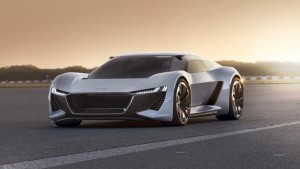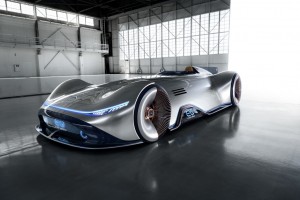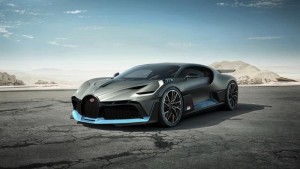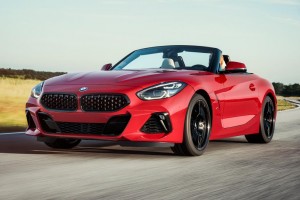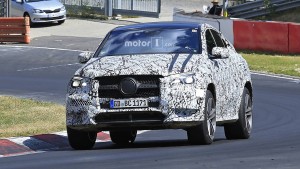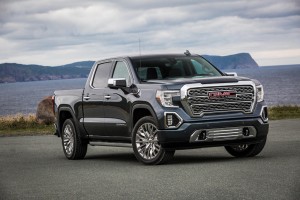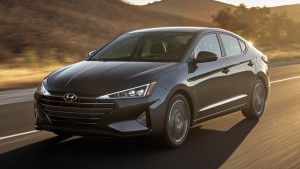Monthly Archives: August 2018
Is Your Connected Car Turning Into A Digital Billboard?

The MBUX or Mercedes-Benz User Experience infotainment system.
The way our connected cars are linked to our smartphones, to manufacturers, and to third-party service providers is done to ensure our utmost convenience and comfort. There is nothing on paper about using the data collected from our cars and turning that data into a marketing ploy.
Marketers know too well how the data collected from a connected car can help them reach a potential $750 billion in profit by 2030. That figure from McKinsey may be astronomical at first but imagine the possibilities of what marketers can do with this kind of data. Thanks to large infotainment screens, they could effectively send out advertisements to your screens at the most effective and opportune time.
Imagine the possibilities. You are cruising along the highway when suddenly your luxury SUV hits a snag and your tires blow. Without a companion, you have to change the tires all by yourself. After fitting the tires, you’re back on the road, but on the next traffic signal, a message on your screen pops out that offers a roadside assistance 24/7 for just $20 a month. After spending an hour changing your tire and having to explain to your boss why you’re late, you may think that a $20 bill isn’t so bad after all. You click to pay and the marketers win.
How about if you’re driving to the mall with your kids in tow when a car suddenly stops in front of you causing you to hit on the brakes hard? The system will send a message to the manufacturer about a near-collision event. The next thing you know, while you’re contemplating about how your kids will live without you, there’s a message on your screen about insurance. The company is offering a life insurance policy, which will protect the future of your kids for just $5. After that run-in with the bad driver, you will be inclined to accept the deal.
More connectivity with our cars means more opportunity for marketers. It’s only a matter of time until our infotainment screens get flooded with ads.
Top 3 Things About The 2018 Audi PB18 E-Tron Concept
The prototype for the 2018 Audi PB18 E-Tron concept was revealed at the Pebble Beach Concours d’Elegance. The concept car blended both functionality and a dynamic style that’s nothing like we saw in an Audi. The best thing about the E-Tron concept, at least for traditional car enthusiasts, is that there is no hint of autonomous tech assistance here.
Exterior
The exterior design is a mixture of the layout of a coupe, the shape of a hatchback, and the profile of an exotic vehicle. Up front, you might see some similarities with Audi’s current supercar, the R8. The Singleframe grille was made prominent because of its hexagon shape. The headlights are made of ultra-thin units that has laser-high beams and are integrated with digital matrix technology.
The PB18 measures 4.53 meters (14.5 feet) long, 2 meters (6.4 feet) wide, and 1.15 meters (4.6 tall), so it’s not exactly a small car.
Interior
The cabin of the PB18 concept car can either be a two-person layout or a single-passenger layout, the latter will likely put the driver in the middle of the cockpit, much like the Mercedes EQ Silver Arrow concept. The windshield is not just a simple glass. It’s an augmented reality system that displays information about the road ahead. Because of the hatchback layout of the concept car, it actually has quite a reasonable amount of cabin space—16.6 cubic feet to be exact.
Drivetrain
The concept car uses three different electric motors—one in the front axle and two in the rear axle. Each of the electric motors can produce 201 horsepower. Combining all three will amount to a whopping 604 horsepower, which can increase to 671 horsepower and 612 pound-feet of torque during normal driving sessions. There’s a temporary boost that allows the engine to make 764 horsepower, which is enough to help the PB18 accelerate from 0 to 62 mph in just over two seconds.
Examining the Beauty of the Mercedes-Benz Vision EQ Silver Arrow
Mercedes-Benz has plenty of history from which they can pull out a concept so beautiful and ethereal that it can make our eyes water. And that’s exactly what they have done when they pulled back the sheet from the Vision EQ Silver Arrow at the Monterey Car Week in Pebble Beach, California.
The concept is a forward-looking take on the legendary streamliners of the 1930s, particularly the W125 Rekordwagen which set the world record for the highest speed on a public road. It held that record for 79 years until the Koenigsegg Agera RS went 8 mph faster last fall. For added context, the Rekordwagen is scheduled to appear alongside this Vision EQ Silver Arrow concept.
The difference would be what’s under the hood. The W125 made its 275 horsepower from a twin-supercharged 5.6-liter V-12 engine while the Vision EQ Silver Arrow will produce 750 horsepower using two electric motors (one per axle) and an 80kWh battery. The W125 can comfortably exceed 250 miles per hour while the Vision EQ is built to produce 250 miles per charge.
The exterior is made of carbon fiber, and to achieve that Silver Arrow appearance, the top layer of the exterior was painted in Alubeam Silver. This is a reference to the unpainted metal of old cars. The liquid-like finish is matched by the very fluid surfacing. You can find not a single crease on the Vision EQ. The only “imperfections” found on the smooth surface were the place where the top surface meets the unpainted front mask and the protruding side skirts.
The 168-spoke wheels are half-covered and they are painted in “rose gold” to loosely resemble the copper wire inside an electric motor. Since this is a concept car, the wheels are naturally so big it’s almost impossible to imagine what tires could fit them.
According to Mercedes, the Vision EQ Silver Arrow is intended to draw on the brand’s legacy of unmatched acceleration and driving pleasure. It “provides an insight into the future of our design.”
Bugatti Divo: The Chiron’s Angry Cousin
Bugatti has finally revealed the Divo and just like that, we can say with absolute certainty that this is a redesigned and more powerful Chiron. It looks exactly like the Chiron except that the Divo has a meaner face, more muscular front hood, corner-mounted headlights, aggressive side skirts, and 1,500 insane horsepower.
The muscular body of the Bugatti Divo was intended for a number of crazy aerodynamic features such as its 1,005 pounds of downforce. That’s 198 pounds more than the standard model. To do this, Bugatti has to make the rear spoiler 23-percent wider than the standard Chiron.
Under the hood, the Divo has an 8.0-liter W-16 unit that can deliver a coldhearted 1,500 horsepower. That’s 30 more than the Chiron. Pair that up with the Divo’s new aerodynamics setting, then that would mean a capacity to generate a lateral acceleration of 1.6 g once you put the pedal to the metal. The top speed would be 236 mph, 25 mph slower than the Chiron’s maximum speed of 261 mph. That’s primarily because Bugatti made the Divo for better handling and agility around the corners.
Even with less the top speed of the Chiron, the Divo is reportedly “eight seconds faster about the Nardo handling circuit”. We’re assuming the figure is compared to the standard Chiron and not the Chiron Sport.
Stephen Winkelmann, president of Bugatti, explained that the modern Bugatti is known for hitting the perfect balance between “high performance, straight-line dynamics, and luxurious comfort.” The Divo wants to change that as it focuses on “lateral acceleration, agility, and cornering.” Simply put, the Divo “is made for corners.”
Inside, the brand wants something different for the Divo. It has a funky, two-tone color scheme that includes a bright colored Alcantara on the driver’s side and a tone-down grey-black Alcantara on the passenger side.
There will only be 40 units of the Divo. Each of those 40 units has already been reserved for a whopping €5 million ($5.8 million).
5 Things To Know About The New BMW Z4
The new BMW Z4 is scheduled to be released next spring and by the looks of it, the Z4 will bring a storm over. Developed in tandem with the new Toyota Supra, the Z4 is every bit similar to the prototype that was seen at the Pebble Beach event last year.
Though the two models will emerge from the same process, they could not be different: the BMW Z4 will be a convertible-only model while the Toyota Supra will be sold as a coupe.
The Z4’s looks and proportions are very similar to the concept previewed last year. There’s a short overhang at the front end and a visible decrease in wheelbase compared with the outgoing Z4.
1. It Has A Fabric Roof
The new Z4 will make use of a fabric roof, foregoing the aluminum hard-top of the outgoing model. The fabric roof can open and close in 10 seconds flat, and it was chosen to be one of the new Z4’s main features on grounds of complexity, cost, and weight. The new car’s total curb weight will be 50 kg lighter than its predecessor. That will give the car better aerodynamics power.
2. The New Lightweight Configuration Speeds Up The Car
At 50 kg lighter, the new BMW Z4 can go from 0 to 62 mph in just 4.6 seconds. That’s largely thanks to a 3.0-liter straight-six petrol engine that produces 340 horsepower. Other powertrains in the lineup include a 2.0-liter four-cylinder petrol, at least one more version of the straight-six unit, a plug-in hybrid version, and a fully focused M version.
3. Its Cabin Has BMW’s Cockpit Layout
The cabin of the Z4 will show an evolved version of BMW’s cockpit layout. It would prominently feature a newly designed digital instrument panel and a “fared-in” infotainment system. The iDrive rotary controller is positioned on the center panel beside the controller.
4. Arrival
The Z4 will be on sale in the UK next spring.
5. Price
We expect the price range to be between $38,000 and $62,000.
Take A Long Look At These 2020 Mercedes-Benz GLE Coupe Spy Shots
Ten years ago, BMW single-handedly introduced this weird coupe-SUV segment by launching the original X6 and following that up with the model’s third generation due next year. On the other side of the coin, Mercedes is doing a similar thing with its Mercedes-Benz GLE Coupe.
Whatever this niche is called, we’re sure about one thing: it’s a premium segment and one that has attracted family-car-loving people. The higher seats plus the better legroom and headroom in the cabin make this car such an enticing prospect for families to have.
Mercedes, particularly, is going all the way with the production-bodied prototype of the GLE Coupe spotted at the Nurburgring just this week. The spy shots show the second-generation model dressed in full camo attire but we can make out its aggressive styling.
Though it’s completely wrapped in camouflage, we can see that there’s a large rear spoiler attached to the tester, which is likely part of an AMG Line styling package. Both LED headlights and taillights appear to have a sleeker shape.
The GLE Coupe is riding high based on the photos, but that’s likely because the air suspension is in the highest possible setting.
The vehicle will use Mercedes’ MHA modular platform that was designed for crossover SUVs, so we should expect similar proportions with its predecessor. This platform, which debuted in the 2016 GLC, is closely related to the German company’s MRA platform which is being used by the automaker’s sedans and coupes.
There are no details about the drivetrains yet, but we expect to see Mercedes’ latest inline-6 with mild-hybrid tech and a twin-turbocharged 4.0-liter V-8 reserved for the Mercedes-AMG GLE63 Coupe. There should also be a plug-in hybrid version in the future.
These engines should be paired with a nine-speed automatic and rear-biased all-wheel-drive system for all trim models.
The GLE Coupe will likely be revealed next year as a 2020 model. But before that, we can expect the debut of the GLE late this year or early next year.
2019 GMC Sierra Denali Is Heading To Dealerships
GMC is entering the future with its updated lineup of pickup trucks that carry new features and technologies. The 2019 GMC Sierra Denali is now arriving in dealerships, ushering in a new era for the Sierra 1500 trucks.
The Sierra 1500 has grown in every dimension for the 2019 model year. According to reports, the truck now has a longer wheelbase and a longer body in crew cab form. To differentiate itself from the Silverado, which are also arriving in showrooms this week, the Sierra 1500 features a different grille, a new tailgate that can be configured into six different positions, and a new carbon fiber pickup box.
The Denali models will include exclusive upgrades such as a bolder front fascia with massive amounts of chrome, adaptive ride control for better body control, and genuine open-pore ash wood trim and dark-finish aluminum inside the cabin. Other significant changes are the heated and ventilated seats, the heads-up display, the 8-inch touchscreen, the rear camera mirror display, and the standard 20-inch aluminum wheels or available 22-inch wheels.
The Denali will be available in crew cab configuration and options for either a rear-wheel or a four-wheel drive. The standard model would come with a 5.3-liter V8 engine paired to an eight-speed automatic. The four-wheel-drive models will come with an option of a 6.2-liter V8 engine that can deliver 420 horsepower and pair with a 10-speed automatic. There are also plans to have a 3.0-liter turbodiesel engine paired with a 10-speed automatic in the Sierra lineup.
The Denali will be the top premium pickup in the Sierra lineup. The two-wheel-drive Denali starts at $54,700 plus a $1,495 destination charge.
The Sierra happens to be a big seller for the GMC. At the end of the second quarter, GMC sold about 100,874 Sierra pickups, up by 1.7 percent from the same period last year.
The Future Is Here With The 2018 Opel GT X Experimental Concept Car
It might only be a concept car for now, but the 2018 Opel GT X Experimental is serious about changing the way we see crossovers in the future. This is the first car that Opel/Vauxhall revealed after the PSA Group’s acquisition of the brand by GM less than a year ago.
The concept car showcases all the important steps that Opel are willing to take to transform the brand. Come 2024, Opel plans to electrify its entire lineup, introduce a new design language, release a number of crossovers, develop an autonomous driving system, and showcase new models. We expect that the Corsa, the Astra, and the Mokka will be replaced by new and exciting models.
What Opel wants is to offer a car that is focused on customer utility and satisfaction, practicality and functionality, and convenience. The design of the 2018 Opel GT X Experimental will be focused on having a height of more than 60 inches and a minimalistic layout, which could be seen on the integration of the rear doors to the rear panel of the car.
It is most likely that the current model the Experimental will closely resemble is the Mokka, which is the smallest Opal crossover that was intended to sit on top of the Chevrolet Trax. Obviously, this new one would be smaller than the Trax.
The GT X Experimental’s electric motors haven’t been revealed yet, but Opel did say that the car will feature a 50-kWh “compact next-generation lithium-ion battery with inductive charging.” All of the newcomers and their successors in Opel’s lineup for the next years will likely be powered by an electric engine, too.
The 2018 Opel GT X Experimental will also be revealed with a Level 3 self-driving ability that Opel will be studying about on the next cars.
2019 Hyundai Elantra Gets New Angular Face
The 2019 Hyundai Elantra is getting a radical facelift that gives the compact sedan a more angular look than before. Gone is the rounded front fascia of the current model and in its place is a fascia with lots of sharp corners. Even the headlights and the fog lights change to triangle-shaped units and the grille is also sharper.
The headlights intersect with the grille so this makes for an interesting new design. The base of the headlights match up with the top-most slat in the grille and the lights intersect with some of the grille’s top corners. The two new creases on the hood are also leveled up with the vertical slats in the grille.
The car’s rear is also updated. The taillights, like the headlights, have sharpened corners. The housing of the license plate is moved to the bumper from the trunk lid. The large Elantra lettering stretches across the lid of the bumper. This design is similar to the Sonata midsize sedan.
The changes are attractive but the angular lines don’t specifically fit the sides. Meanwhile, the overall silhouette of the car retains the soft and organic lines of the current model.
The safety features of the car are improved. The 2019 Hyundai Elantra gets a camera-based forward collision prevention, lane-keeping assist, and driver attention alert as standard equipment on the second-lowest SEL trim and above.
On the other hand, all trim levels come with a five-inch touchscreen as standard along with a rear-view camera and dynamic guidelines on the screen.
The base SE model is paired with a manual transmission but equipped with Bluetooth and steering wheel controls. The Limited trim, the top end of the model, has an additional eight-speaker sound system with subwoofer, Qi wireless phone charging, and Safe Exit Assist, which warns drivers of approaching cars when the door is open.
Under the hood, we find the same naturally aspirated 2.0-liter four-cylinder that produces 147 horsepower. There’s also the 1.4-liter engine that makes 128 horsepower. The Elantra Sport churns out 201 horsepower, but Hyundai said they will have a restyled version later this year.
Europe Is Finally Getting The Ford Ranger Raptor
Ford is making the Ranger Raptor available in Europe by 2019. The announcement was made through the Gamescon video game show as the pickup truck will also make its video game debut in Forza Horizon 4.
Just like its Asian market counterpart, the Ranger Raptor will use a twin-turbocharged 2.0-liter diesel four-cylinder engine that can produce 210 horsepower and 369 pound-feet of torque. Pairing this engine with a 10-speed automatic transmission, the turbochargers can operate in a sequential pattern with the smaller unit operating at lower revs and the larger unit taking the higher rpm band.
The transmission is programmed in such a way that the driver can override the system anytime via the paddle shifters. The chassis, in particular, has been tuned for off-road performance and it also features Fox shocks with Positive Sensitive Damping.
For better handling, the Ford Ranger Raptor is finished with BF Goodrich all-terrain tires on 17-inch wheels. These come standard with a front skid plate made of high-strength steel. There are six modes that the Ranger Raptor can be driven such as Normal, Sport, Grass/Gravel/Snow, Mud/Sand, Rock, and Baja for high-speed off-road driving.
Inside, the Ranger Raptor will feature Ford’s Sync 3 infotainment system, Apple CarPlay, Android Auto, and 8.0-inch touchscreen. The seats are now Raptor-specific sports seats that come upholstered in a suede-like material and leather with blue stitching.
The things that distinguish the Ranger Raptor from a regular Ranger are its unique front grille, flared composite front fenders that can accommodate longer suspension travel and oversized tires, side step boards that also prevent rock spray, and air curtains on the front fender for better air flow.
Sadly, we won’t see the Ranger Raptor on the US soil. This model was made specifically for other markets where the F-150 isn’t sold and diesel is more popular.

